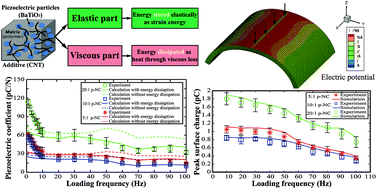Analytical, numerical, and experimental studies of viscoelastic effects on the performance of soft piezoelectric nanocomposites†
Abstract
Piezoelectric composite (p-NC) made of a polymeric matrix and piezoelectric nanoparticles with conductive additives is an attractive material for many applications. As the matrix of p-NC is made of viscoelastic materials, both elastic and viscous characteristics of the matrix are expected to contribute to the piezoelectric response of p-NC. However, there is limited understanding of how viscoelasticity influences the piezoelectric performance of p-NC. Here we combined analytical and numerical analyses with experimental studies to investigate effects of viscoelasticity on piezoelectric performance of p-NC. The viscoelastic properties of synthesized p-NCs were controlled by changing the ratio between monomer and cross-linker of the polymer matrix. We found good agreement between our analytical models and experimental results for both quasi-static and dynamic loadings. It is found that, under quasi-static loading conditions, the piezoelectric coefficients (d33) of the specimen with the lowest Young's modulus (∼0.45 MPa at 5% strain) were ∼120 pC N−1, while the one with the highest Young's modulus (∼1.3 MPa at 5% strain) were ∼62 pC N−1. The results suggest that softer matrices enhance the energy harvesting performance because they can result in larger deformation for a given load. Moreover, from our theoretical analysis and experiments under dynamic loading conditions, we found the viscous modulus of a matrix is also important for piezoelectric performance. For instance, at 40 Hz and 50 Hz the storage moduli of the softest specimen were ∼0.625 MPa and ∼0.485 MPa, while the loss moduli were ∼0.108 MPa and ∼0.151 MPa, respectively. As piezocomposites with less viscous loss can transfer mechanical energy to piezoelectric particles more efficiently, the dynamic piezoelectric coefficient (d′33) measured at 40 Hz (∼53 pC N−1) was larger than that at 50 Hz (∼47 pC N−1) though it has a larger storage modulus. As an application of our findings, we fabricated 3D piezo-shells with different viscoelastic properties and compared the charging time. The results showed a good agreement with the predicted trend that the composition with the smallest elastic and viscous moduli showed the fastest charging rate. Our findings can open new opportunities for optimizing the performance of polymer-based multifunctional materials by harnessing viscoelasticity.



 Please wait while we load your content...
Please wait while we load your content...